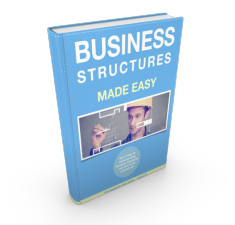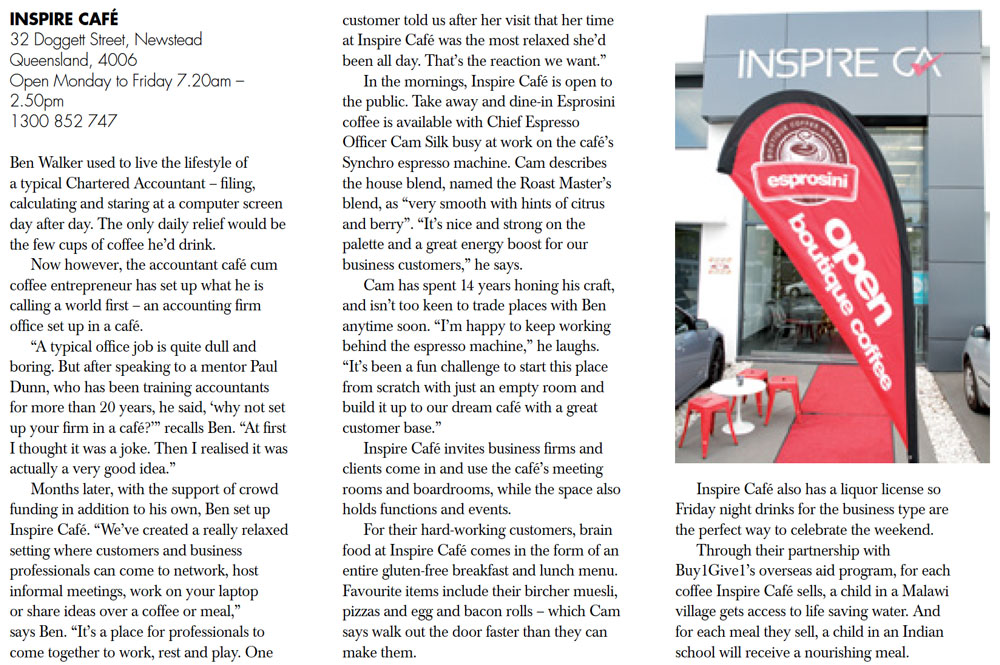Business Structures Made Easy! Part 3: Partnerships
A partnership is a common and relatively inexpensive way to set up a business. It involves 2 or more co-owners (the partners) participating together in a business operation. In order for a partnership to exist the partners must have the intention of making and sharing profits, as well as an understanding that they will each act on behalf of the other in all business dealings.
When establishing a business under a partnership structure, a formalised partnership agreement spelling out the rights, responsibilities and obligations of each partner is a good idea, although it is not necessary for the partnership to exist. In the absence of a partnership agreement The Partnership Act of 1891 sets out the various rules that govern the conduct of partners. The act places joint liability on all partners for debts and obligations incurred by the business during their involvement in the partnership. Partners are obligated to keep their co-owners properly informed.
While a partnership is a separate business operation to the partners involved, having its own Australian Business Number (ABN) and Tax File Number (TFN), all the business profits are taxed in the hands of the partners at their respective marginal tax rates.
Pro’s and Con’s of Partnerships as a Business Structure
Advantages of a Partnership:
- Easy and inexpensive to establish and maintain;
- Fewer reporting requirements;
- Any losses incurred by the business may be offset against other income earned (such as investment income or wages) subject to satisfying certain conditions; Partners are not considered an employee of their own business and are free of any obligation to pay payroll tax, superannuation contributions or workers’ compensation on income drawn from the business;
- Relatively easy to change your legal structure if the business grows, or if you wish to wind things up.
Disadvantages of a Partnership:
- Unlimited liability which means all personal assets are at risk if the business operation gets into trouble; Some of the control of business assets and decisions is relinquished;
- Business debts and losses cannot be shared with anyone except the partners;
- Requirements to pay preliminary tax on business income which may not have been earned;
- Limited access to additional capital for business growth;
Click Here to Download our eBook “Business Structures Made Easy”
What do we think of Partnerships?
While a partnership can allow a business access to additional capital and knowledge (if the partners are both individuals rather than companies and trusts), each partner exposes their personal assets to an unlimited level of business risk. We recommend business owners avoid operating partnerships, especially involving two or more individuals. If you are currently considering a partnership as a business structuring option we recommend you read our later articles in this series that look at companies and trusts, or contact Inspire CA for assistance.
Inspire Cafe – Bean Scene
This article was originally published in the April 2014 issue of Bean Scene magazine. Article written by Sarah Baker.
 Inspire Cafe
Inspire Cafe
32 Doggett Street, Newstead Queensland, 4006
Open Monday to Friday 7.20am – 2.50pm
1300 852 747
Ben Walker used to live the lifestyle of a typical Chartered Accountant – filing, calculating and staring at a computer screen day after day. The only daily relief would be the few cups of coffee he’d drink.
Now however, the accountant cafe cum coffee entrepreneur has set up what he is calling a world first – an accounting firm office set up in a cafe.
“A typical office job is quite dull and boring. But after speaking to a mentor Paul Dunn, who has been training accountants for more than 20 years, he said, ‘why not set up your firm in a cafe?'” recalls Ben. “At first I thought it was a joke. Then I realised it was actually a very good idea.”
Months later, with the support of crowd funding in addition to his own, Ben set up Inspire Cafe. “We’ve created a really relaxed setting where customers and business professionals can come to network, host informal meetings, work on your laptop or share ideas over a coffee or meal,” says Ben. “It’s a place for professionals to come together to work, rest and play. One customer told us after her visit that her time at Inspire Cafe was the most relaxed she’d been all day. That’s the reaction we want.”
In the mornings, Inspire Cafe is open to the public. Take away and dine-in Esprosini coffee is available with Chief Espresso Officer Cam Silk Sbusy at work on the cafe’s Synchro espresso machine. Cam describes the house blend, named the Roast Master’s blend, as “very smooth with hints of citrus and berry”. “It’s nice and strong on the palette and a great energy boost for our business customers,” he says.
Cam has spent 14 years honing his craft, and isn’t too keen to trade places with Ben anytime soon. “I’m happy to keep working behind the espresso machine,” he laughs. “It’s been a fun challenge to start this place from scratch with just an empty room and build it up to our dream cafe with a great customer base.”
Inspire Cafe invites business firms and clients come in and use the cafe’s meeting rooms and boardrooms, while the space also holds functions and events.
For their hard-working customers, brain food at Inspire Cafe comes in the form of an entire gluten-free breakfast and lunch menu. Favourite items include their bircher muesli, pizzas and egg and bacon rolls – which Cam says walk out the door faster than they can make them.
Inspire Cafe also has a liquor license so Friday night drinks for the business type are the perfect way to celebrate the weekend.
Through their partnership with Buy1Give1’s overseas aid program, for each coffee Inspire Cafe sells, a child in a Malawi village gets access to life saving water. And for each meal they sell, a child in an Indian school will receive a nourishing meal.
CGT Main Residence Exemption – Tips, Tricks, and Traps
Under ordinary circumstances the sale of a property would attract Capital Gains Tax (CGT). However, you can avoid paying CGT if you sell a dwelling that is considered to be your main place of residence. But what is your ‘Main Residence,’ and how do you know if the exemption applies?
Is the Property I’m Selling my Main Residence?
Generally speaking, your main residence is your home. A few examples of factors the Australian Taxation Office (ATO) considers relevant in identifying your main residency are:
- Whether you and your family live there;
- Whether you have moved your personal belongings into the home;
- The address to which your mail is delivered;
- Your address on the electoral roll
- The connection of services and utilities (for example, phone, gas, or electricity);
- Your intention in occupying the dwelling.
Please note there is no minimum time a person has to live in a home before it is considered to be their main residence
In order for the Main Residence CGT exemption to apply, the property being sold must include a dwelling. A dwelling is anything that is used wholly or mainly for residential accommodation. Examples of a dwelling are:
- a home or cottage;
- an apartment or flat;
- a strata title unit;
- a unit in a retirement village;
- a caravan, houseboat or other mobile home.
A mere intention to construct or occupy a dwelling as your main residence – without actually doing so – is not sufficient to obtain the exemption. You must physically occupy the dwelling.
Can I Have More Than One Main Residence?
You can only ever have one main residence at any given point in time unless you’re selling your old main residence and buying another. In this case you’re entitled to an overlap period of six months as long as:
1) the new property will be your main residence after the sale of the old property;
2) you lived in the old property for at least three continuous months in the 12 months prior to sale; and
3) it wasn’t used to produce rent in this same 12 month period.
Can I Earn Rental Income from My Main Residence?
While you can only have one main residence at any point in time you do not need to live in the dwelling for the entire holding period for it to continue to qualify for the exemption. If you own a property which is currently your main residence you can move out of the property for up to six years. During that time you can earn rental income on the property and claim a tax deduction for expenditure as you would with a normal investment property. Providing you re-occupy the building before the end of the six period and do not dispose of the property within the same financial year that the property was earning rental income you can still qualify for the full exemption.
Does the Main Residence Apply to Property Renovators?
The simple answer is yes! If you purchase a property, occupy the dwelling while undertaking renovations and then sell the property only to move into another dwelling and repeat the process, any profit you make on the sale of each property is generally tax exempt.
Can I Subdivide My Block of Land and Apply the Main Residence Exemption to the Proceeds from the Sale?
As discussed, the main residence exemption requires a dwelling to exist on the property that is sold. If you have a large block of land and subdivide the land so that you can sell off a part of the unused land, there is typically not a dwelling on this parcel. Therefore, any profit on this sale would attract Capital Gain Tax.
However, it is important to note that if the reverse situation applies and you purchase the neighbouring block of land to obtain a larger back yard, the main residence exemption will apply to the sale of your main residence and the adjoining block provided both properties are sold together and the total area of land does not exceed 2 hectares.
What if I Can No Longer Live in My Main Residence?
The main residence exemption can also apply where the owner is no longer able to reside in the dwelling, because they have lost the ability to live independently and require full time care. This ensures that property owners who spend extended a period in hospital, must relocate to a residential care facility, or who relocate to live with a care giver can still access the main residence exemption when they sell the property to pay living and medical expenses.
[Podcast] The accountant with a coffee shop in his office. – Pricing Power
The original article was published by Pricing Power on 26 March 2014. Written by Steve Major. You can access the Pricing Power podcast here.
Why would an accountant open a coffee shop as part of his accounting business? Ben Walker did and it has created a fantastic business.
Ben Walker lists himself as the Chief Inspiration Officer of Inspire CA (the accounting firm) and the Beer Development Manager of Inspire Cafe Inspire CA has its mission to inspire people to build phenomenal businesses. The dream for the cafe is create a place where you can enjoy a good coffee and something decent to eat with entrepreneurs and business people.
In the short time that Ben has been in business he has made a mark. I first heard of Ben from a colleague in the United States. Impressive. The cafe is fast becoming a hub for business events and a thriving community.
And by the way Ben does not do timesheets, he value prices, extensively uses the cloud amongst other impressive aspects of his business. During this interview we talk about why he created the Coffee shop and how that changed his business. As Ben talks about it has not all been plain sailing but he has fought hard to create this fantastic business.
Business Structures Made Easy! Part 2: Sole Trader
Should I Trade as a Sole Trader?
Establishing a business as a sole trader is the simplest form of business structure. It is relatively easy and inexpensive to start and maintain.
Many sole traders choose to trade under their own name but this is not a requirement. A sole trader can register a business name with the Australian Securities and Investments Commission (ASIC) and trade using this name instead.
A sole trader is essentially just the individual in business for themselves – they retain complete control of the business operation. There is no division between business assets or personal assets, which includes any assets jointly owned with another person (such as your house or car).
Your liability is unlimited which means that personal assets can be used to pay business debts. The individual is also responsible for remitting the tax on any business profits made at their marginal income tax rates.
After your first year of business profits the Australian Taxation Office will enter you into the pay as you go (PAYG) instalments system. The PAYG system requires regular payments of preliminary tax based on expected profits for the following year. Any excess tax paid as a result of this will be refunded on lodgement of your income tax return.
Pro’s and Con’s of Running a Business as a Sole Trader
Advantages of Trading as a Sole Trader
- Easy and inexpensive to establish and maintain; Complete control of your assets and business decisions is retained by individual;
- Fewer reporting requirements;
- Any losses incurred as a result of business activities may be offset against other income earned (such as investment income or wages), subject to satisfying certain conditions;
- You are not considered an employee of your own business and are free of any obligation to pay payroll tax, superannuation contributions or workers’ compensation on income your draw from the business;
- Relatively easy to change your legal structure if the business grows, or if you wish to wind things up.
Disadvantages of Trading as a Sole Trader
- Unlimited liability which means all your personal assets are at risk if the business operation gets in trouble;
- Little opportunity for tax planning – you can’t split business profits or losses made with family members and you are personally liable to pay tax on all the income derived;
- Business debts and losses cannot be shared;
- Requirements to pay preliminary tax on business income which may not have been earned;
- Limited access to additional capital for business growth;
Click Here to Download our eBook “Business Structures Made Easy”
Word of Warning Against Trading as a Sole Trader
At Inspire CA we strongly recommend business owners avoid operating as a sole trader.
Even a business which is not generating sufficient income to require a great deal of tax planning can still expose the owner’s personal assets to significant risk.
If you are currently operating a small business as a sole trader please refer to the articles later in this series which explore your alternative structuring options, or contact Inspire CA for assistance.
Business Structures Made Easy! Part 1: The Basics
One of the most important decisions a business owner needs to make (after the name of the business of course!) is the choice of business structure. In fact, getting this choice right is so important that we begin the analysis of every potential client with their proposed business structure and we then work out from that point.
Click Here to Download our eBook “Business Structures Made Easy”
Choosing Your Business Structure
The choice of how to structure your business depends on a number of factors:
- The type of business you operate;
- Your personal financial circumstances;
- How large you intend to grow the business; and
- Whether you are building the business to operate or to sell.
|
A basic comparison of the most common business structures is provided below: |
||||
| Cost to establish and operate |
Low |
Medium |
High |
High |
| Complexity |
Simple |
Moderate |
Complex |
Complex |
| Limited Liability |
No |
No |
Yes |
Yes (with a corporate Trustee) |
| Do I receive full profits made from the business? |
Yes |
No |
No |
No |
| Can I employ staff? |
Yes |
Yes |
Yes |
Yes |
| Do I have to pay myself superannuation? |
No |
No |
Yes |
No |
| Can I change the legal structure easily? |
Yes |
No |
No |
No |
| Ability for tax planning e.g. income splitting? |
No |
Limited |
Limited |
Yes |
| Is it easy to raise capital? |
No |
No |
Yes |
Yes |
| Is it easy to dissolve or exit? |
Yes |
Yes |
No |
No |
Each structure has advantages, disadvantages and responsibilities which need to be considered before making a decision. While it is possible to change the structure as the business grows or your circumstances change, getting the structure right in the first place can avoid any unnecessary tax and administration costs. Your accountant or business adviser can help you make the right choice for your business.
Where Do You Go from Here?
Choosing the right business structure is extremely important. We strongly recommend seeking professional advice before making a final decision. We offer a wealth of experience in business structuring and can help you make the right choice now and avoid problems later on.
For additional information please look out for our future articles which look at each of the business structuring options in more detail.
Email Speed Dating: Tackling 50 emails in 50 minutes
Every second and fourth Friday of the month we hold the Inspiring Business at Inspire Cafe event. It’s a great way to wrap up a big week! Recently, I’d made a breakthrough in something that I now know a lot of people struggle with, so shared it as our “Win of the Week”.
One thing that has plagued me for quite a while was my inability to achieve what some call ‘Inbox Zero’. Despite my best efforts, I had what I called ‘Inbox 120’. On average I ended each day with 120 unread emails! The subconscious weight on my shoulders was overbearing and I realised something must be done.
Over a weekend, I was able to deal with the vast majority of these unread emails. Not only that, but I was able to apply what I learned with this exercise and now there’s no struggle to totally clear my Inbox each time I sit down to it. Until I shared this at the Inspiring Business breakfast, I didn’t realise it was such a common problem!
I’d love to share with you the ‘tricks’ I learned to kill 50 emails in 50 minutes.
Radio Silence: Allocate Uninterrupted Time
You can’t deal with your inbox piecemeal, with endless distractions. Block out time in your calendar ahead of time. Let your team know you’re going 
1. Disconnect from WiFi so you won’t be distracted by Facebook, incoming emails, the urge to check the news etc. Some of you won’t be able to disconnect from WiFi especially if your email is hosted online, but do your best to get rid of procrastination-related distractions.
2. Activate your phone’s ‘Do Not Disturb’ mode. If someone calls or texts during Do Not Disturb mode, the screen of the phone stays blank. Usually you have the ability to make exceptions to this by tagging ‘Favourites’ in the contact list for family or close friends so they can get through to you if there is something pressing.
The Shot Clock: Set a Countdown Timer
A countdown timer in your peripheral vision does wonders for keeping you on task and focussed. There are a number of ways you could do this, like using an App or a website such as e.ggtimer.com. Whatever your method, make sure you can see it while you work.
e.ggtimer.com has only one function, which is a countdown timer in a web browser. Choose how long you wish to count down, simply add the time after the web address, for example:
– 50 minutes would be: http://e.ggtimer.com/50minutes
– 60 seconds would be: http://e.ggtimer.com/60 (if nothing is written after your number, the site assumes seconds).
Keep It Simple, Stupid: Reply Using Four Sentences
Another thing that I struggle with is not getting too bogged down into the pleasantries. When your clients are also good friends, it’s hard not to check in on how their newborn is, or where they’ve travelled and so on … but there is a better method for doing that – it’s called picking up the phone!
But getting back to email: My tip is to simply get straight to the core of the email.
A website that has been designed to aid in this problem is four.sentenc.es. This policy keeps your responses brief, fast, and efficient, allowing you to respond in one minute or less to every email. The web site offers a template for a signature you can add automatically to your emails explaining your brevity.
Hit the Ground Running: Set Yourself Up for the Week
After reading a LinkedIn article a few months ago about starting your week on a Sunday afternoon, I’ve implemented a couple of recommendations from the article, including clearing email and small tasks before the week starts. This stuff works a treat for your Monday Mindset!
In Summary
There’s quite a bit to implement here, but it’s all low cost and fairly easy to do. In summary, your moves are:
– Plan out and allocate uninterrupted time;
– Set a countdown timer;
– Reply using four sentences or less;
– Clear emails (and other small tasks) before the week starts.
Shoot to Thrill! How to Hit Your Business Targets Every Time
Whether you think precision shooting (or “sniping”) is an art or a sport, you soon learn how much technical skill is involved.
You also learn how much difference there is between a skilled shooter and a beginner.
Like most things, the more you practice the better you get. But in this case, you can learn a lot just from what happened with your previous shot.
And it’s the same with determining what to target with your business.
The most logical thing to target
If it’s your first time at the range, you’d probably aim the crosshairs directly at the target. After all, that’s what you’re trying to hit, right?
Unfortunately there’s a good chance you’ll miss completely.
Why? Because there’s a good chance you didn’t factor in wind speed, heading, bearing, angle, elevation, target speed, and so on. Each one can affect the outcome, and unless you change your aim to compensate for them, you’ll keep missing your target.
And it’s the same with aiming for profits in your business. They should definitely be your target, especially if you want your business to still be around in a few years. But they’re not always what you should be aiming for.
Factor in the variables
Just as precision shooter compensates for everything that will affect the bullet’s path, you should compensate for everything that can affect your profit. This could include things such as:
-
Average transaction value
-
Retention rate
-
Number of transactions per client per year
-
Number of new leads
-
Any other indicators that affect those numbers.
Lead vs. Lag Indicators

Lag indicators are end results. Lead indicators are the activities that create results.
Unfortunately, a lot of business owners don’t plan how to get there: they fail to identify the lead indicators that produce the lag indicators.
For instance, revenue comes from converting leads, getting these new clients, and helping them with relevant products.
How do you know where to focus? How do you choose your lead indicators? This will be dictated by the challenges your business is currently facing.
If you’re team isn’t very busy, and there’s not a lot of profit left at the end of the month, your indicators may well be acquiring and converting customers. On the other hand, if you’ve got too many clients to keep up with but no money in the bank, focusing on your average transaction value (i.e. putting your prices up) could be the key.
Shoot to thrill!
Thinking about where you’re aiming instead of the target won’t be easy to begin with. After all, you’re in business to make a profit, so it’s natural to make it your main focus.
But by thinking less about this lag indicator, and more about your lead indicators, your business will soon be hitting your targets. With consistency. And precision.
Don’t Drive Your Business with Crap on the Windscreen – Why Xero Keeps it Clean
Imagine you’ve unknowingly parked under a tree full of birds, who all decide to use your windscreen for target practice. By the time you hop back in your car is covered in so much crap you can barely see the road, let alone what’s coming up ahead.
Now, would you start the engine and drive away?
You may think it’s a stupid question to ask. Of course you wouldn’t. That would be dangerous. But as we mentioned in our previous post of things that Business Owners need to implement to be successful, many businesses operate just as dangerously because their financial reports and forecasts aren’t up-to-date.
The shocking truth
Most accountants report on and deliver to clients using data that can be more than 11 months old.
It’s true. When accountants prepare a business’ End-Of-Year financials for June, they typically use bookkeeping records up to May the following year. And if the accountant provides any additional value (other than lodging the tax return), their advice is based made from the figures reported in these financials.
Ignoring everything that changed between July and May–practically an entire year.
As business owners, we often look to our accountants for advice. But if that advice comes only once a year, based on what may well be year-old data, how can we reliably hit our targets?
Fortunately for our business clients, Inspire CA takes advantage of a tool that can significantly improve report turnaround times.
Introducing cloud-based accounting software
The key to having live and (almost) real-time financial data is cloud-based accounting software. And that’s where our business clients have the advantage, because they all use Xero. We are solely Xero accountants.
Xero can connect directly with their bank, and receive expense information from photo-recognition data entry software and other add-ons to automate and streamline their reporting.
And because Xero is cloud-based, their data is never more than a few days old and can be reconciled quickly and easily each day, ready for reporting.
Another great benefit is their advisers can access the reporting and data just as easily. And as an adviser, there’s nothing like being able to run your eyes over a client’s reports and call to either congratulate them or see how things are going (depending on the figures).
The benefits of real-time reporting
It’s vital to know what’s happening in the business world in real-time. Trends are shifting more and more quickly, and you need to know how your business is performing and responding to internal and external forces. It’s the only way you can make clear financial decisions.
And that’s what makes cloud-based accounting such a smart business decision.
How many days after the month is over do you get your reports? If it’s more than 30 days, things really needs to improve. If you’re thinking about outsourcing your monthly bookkeeping, aim to have them ready no later than two weeks after the month is over. And if you’re doing your own bookkeeping, you should finish reconciling them within a week.
Make or break your business with Xero
Hopefully I’m preaching to the converted. But if you haven’t switched to cloud-based accounting software, do it now. You’ll have the information you need to make important decisions in real time.
Which is a lot better than trying to drive with business crap all over your windscreen.


 Inspire Cafe
Inspire Cafe




